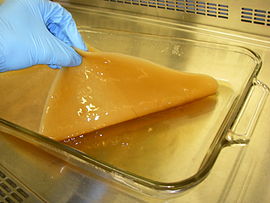- Microbial cellulose
-
 SEM micrograph of the wet structure of microbial cellulose
SEM micrograph of the wet structure of microbial cellulose
Microbial cellulose is a form of cellulose that is produced by bacteria. It is widely used in the traditional Filipino dessert Nata de coco. Microbial cellulose was first confirmed as cellulose in 1886.[1]
Contents
Production
Bacteria from the genera Aerobacter, Acetobacter, Achromobacter, Agrobacterium, Alacaligenes, Azotobacter, Pseudomonas, Rhizobium and Sarcina synthesize cellulose.[2] However, only the Acetobacter species produce enough cellulose to justify commercial interest. The most extensively studied member of the Acetobacter species is Gluconacetobacter xylinus, formerly known as Acetobacter xylinum.[2]
G.xylinus extrudes glucan chains from pores into the growth medium. These aggregate into microfibrils, which bundle to form microbial cellulose ribbons. Various kinds of sugars are used as substrate. Production occurs mostly at the interface of liquid and air.
Differences with plant cellulose
Some advantages of microbial cellulose over plant cellulose include:
- Finer and more intricate structure
- No hemicellulose or lignin need to be removed
- Longer fiber length: much stronger
- Can be grown to virtually any shape
- Can be produced on a variety of substrates
- The formula of the media used and the strain of Acetobacter xylinum will determine the quality of the pellicle
- More absorbent per unit volume
Disadvantages for commercial use
Some issues that have prevented large scale commercialization so far include:
- High price (about 100 x more than plant cellulose)
- Because of high priced substrates: sugars
- Low volumetric yields
- Lack of large scale production capacity
- Timely expansion and maintenance of the cell culture for production
Functions
One continuing mystery surrounding microbial cellulose is its exact biological function. A. xylinus recently renamed as "Gluconacetobacter xylinus" is a successful and prevalent bacterium in nature, frequently finding a home in rotting fruits and sweetened liquids. The most familiar form of microbial cellulose is that of a pellicle on the top of a static cultured growth media. It has thus been hypothesized that cellulose acts as a floatation device bringing the bacteria to the oxygen rich air-media interface. This hypothesis has largely been discredited by experiments conducted on submerged oxygen-permeable silicone tubes that show cellulose grows well submerged if enough oxygen is present.[3] Others suspect that cellulose is used to immobilize the bacteria in an attempt to keep it near the food source; or as a form of protection against ultraviolet light.[4]
Uses
Medical
Microbial cellulose is biocompatible and non-toxic making it a good candidate material for medical applications.[5] So far it has found a commercial role in some wound dressings. There is on-going research to evaluate a possible role for bacterial cellulose in the following applications:
- Scaffolds for tissue engineering
- Synthetic dura mater[6]
- Bladder neck suspension
- Soft tissue replacement
- Artificial blood vessels
Non medical
- Matrix for electronic paper
- High strength paper
- Diet foods
- Desserts: nata de coco
- Substrates for OLEDs
- Sony has use microbial cellulose as an acoustic membrane in high-end earphones[7]
- It has a proposed use as a gloss surface finish in magazines[8]
References
- ^ S. Kuga and R. M. Brown, "Silver labeling of the reducing ends of bacterial cellulose," Carbohydrate Research, vol. 180, no. 2, pp. 345-350, 1988.
- ^ a b P. Ross, R. Mayer, and M. Benziman (1991) "Cellulose biosynthesis and function in bacteria," Microbiol Mol Biol Rev, vol. 55, no. 1, pp. 35-58, Mar.
- ^ T. Yoshino, T. Asakura, and K. Toda, "Cellulose production by Acetobacter pasteurianus on silicone membrane," Journal of Fermentation and Bioengineering, vol. 81, no. 1, pp. 32-36, 1996.
- ^ S. Williams and R. Cannon, "Alternative Environmental Roles for Cellulose Produced by Acetobacter xylinum," Applied Environmental Microbiology, vol. 55, pp. 2448-2452, Oct. 1989.
- ^ G. Helenius, et al., "In vivo biocompatibility of bacterial cellulose," Journal of Biomedical Material Research: Part A, vol. 76A, no. 2, pp. 431-438, 2005.
- ^ "SyntheCel Dura Replacement in Patients Requiring Dura Repair". ClinicalTrials.gov. http://clinicaltrials.gov/ct2/show/NCT00454844. Retrieved 2010-03-31.
- ^ Y. Nishi, et al., (1990) "The structure and mechanical properties of sheets prepard from bacterial cellulose," Journal of Material Science, vol. 25, no. 6, pp. 2997-3001.
- ^ D. C. Johnson, A. N. Neogi, and H. A. Leblanc, (Mar. 10, 1988) "Bacterial cellulose as surface treatment for fibrous web," U.S. United States Patent 4861427
Categories:
Wikimedia Foundation. 2010.

